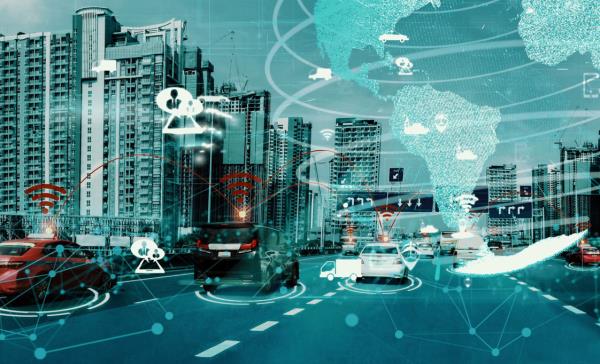09 October 2023

Asia might be leading the way in global smart city initiatives, but what roles must CSPs play to guarantee success?
Smart cities are taking the world by storm, utilising modern wireless connectivity to enhance the lives of citizens across the globe. From intelligent street lighting that changes with the season, to public bins that notify maintenance when they need emptying or traffic lights which warn officials of road blocks – smart city developments offer governments an efficient, sustainable solution for urban centre management.
The world’s leading smart city developments, according to Juniper Research – Shanghai, Seoul, Shenzhen, Sydney, and Beijing – are all situated in the Asia Pacific (APAC) region. Notably, none reside in southern or southeastern Asia. Spending for Asia’s smart cities is expected to reach $42 billion by 2028, up from $19 billion in 2023. However, growth is higher at 303% for 2023-2028 in the rest of APAC when compared to India (231%) and Far East and China (76%). Slower growth in the latter region is attributed to mature projects there compared with the emerging markets for the rest of APAC.
“Current estimates by the United Nations say that by the end of the decade, over 60% of the global population will be concentrated in cities. Nowhere will this growth be more evident than in Asia, dramatically challenging the delivery of connectivity and public services,” says Dominic Smith, marketing director, Cerillion.
And it’s not just cities benefiting from smart technologies: “from my experience, southern Asia has taken a leadership role in smart city development over the past decade,” says Simon Vaughan, chief commercial officer, GlobalReach Technology. “This ambition goes beyond cities and into creating entire smart states.”
Communications service providers (CSPs), naturally, play a crucial role in enabling smart cities, leveraging advanced technologies to enhance the quality of life for residents, improve efficiency, and promote sustainability.
“CSPs are essential partners in building and optimising smart cities. Their expertise in connectivity, data management, security, and monetisation, are all vital for the successful implementation of intelligent, efficient, and sustainable smart cities in southern Asia,” says Smith.
The success of Asia’s smart cities ultimately rely upon network infrastructure. Modern, efficient, high-speed networks deployed and maintained by CSPs enable IoT devices, sensors, data transmission, machine-to-machine communications, etc., all the cogs that comprise a smart city. Reliable real-time data collection and transfer is a must to enable the monitoring of so many smart city initiatives like the monitoring of air quality, traffic, waste management, utilities, and so on. CSPs facilitate the communication between devices and central data platforms and transmit to data centres for management and cloud services that enable cities to store and process large volumes of data efficiently.
“Communication networks therefore play a critical role,” explains Kunal Shukla, senior vice president of technology, Digital Barriers. “By providing reliable, secure, and high-speed connectivity, communication networks can help to improve the efficiency of city operations, make better decisions, and ultimately improve the quality of life for citizens.”
“As urban environments become increasingly connected and data driven, CSPs can provide the essential communication networks and city services, using smart devices, sensors, and IoT to gather data and optimise various processes, manage critical infrastructure and transportation systems, and enable access to public services,” says Smith.
CSPs throughout Asia are working closely with local governments and authorities to understand and action their specific needs, offering customised solutions to meet unique local demand. While local authorities and often central government will form the strategic plan and be clear about their vision, CSPs are the right partners to lead the deployment, asserts Vaughan.
“I want to stress the term ‘partnership,’ because smart city deployments around the world are usually handled by conglomerates working together, to drive and support economic growth, and improve collaboration and connectivity for the regions and citizens,” says Vaughan. “The role of the CSP is to share the same ambition, understand the environment and design and deploy a connectivity service that can transform public services and IoT connectivity to modernise and transform public utilities, transport and communications.”
Data security in a smart world
With the vast quantities of data flowing through smart city networks and infrastructure, data privacy and security becomes a concern. Network owners and operators are obliged to uphold privacy standards, protect citizen data, and comply with relevant regulations.
“With the enormous amount of data being collected and analysed, it is imperative to take a holistic approach that prioritises data privacy and security by design at all layers within smart city solutions,” says Shukla. “Technology is very important here as are the people and processes that surround it. For example, a privacy impact assessment should be conducted for all smart city deployments that collect or process personal data. There should also be clear governance frameworks in place to ensure privacy and security are always front of mind in the design, development, and operation of smart city solutions.”
However, according to Vaughan, “collecting personal data is not absolutely necessary to provide smart city connectivity. GlobalReach Technology works in many global smart city environments where the service provider prioritises the user experience over data collection. This means users get online quicker, using other login experiences.”
From a technology standpoint, says Shukla, the encryption of all data at rest and in transit, the implementation of strong protocols for authorisations, and authentication and the use of data anonymisation wherever feasible are just some of the protections that should be put in place.
Anonymisation or pseudonymisation of data can reduce the risk of individuals being identified, helping protect the privacy of citizens while still enabling valuable data analysis. Data minimisation - collecting only the data necessary for the intended purpose – should also be practiced, avoiding excess data collection, and retaining data only for as long as required by law or the specific use case.
“Ideally, where data is collected, the best practice in our view is that the communications provider should not hold any PII (identifiable information / data) in their system,” shares Vaughan. “It’s unnecessary and strictly doesn’t belong to them. The communications provider should pass any data onto the service provider or the venue to hold in their CRM or other secure database.”
Regular privacy audits and assessments to evaluate data handling practices and identify areas for improvement can help ensure ongoing compliance with privacy standards; and collaboration between CSPs and smart city authorities, technology vendors, and other stakeholders to develop privacy-preserving solutions and strategies for data collection and use within the smart city ecosystem should also be adopted to build trust and ensure the responsible development of smart cities.
Moreover, in the event of a data breach, CSPs should have processes and procedures in place to detect, report, and respond to breaches promptly. This includes notifying affected parties and relevant authorities as required by data protection laws.
“As Spiderman’s Uncle Ben said, with great power comes great responsibilities,” adds Shukla.
Are smart cities the answer?

Dominic Smith
According to Statista, as of 2022, 60% of the global population resides in Asia, and while the region doesn’t have growth rates comparable to Africa, 1.84% population expansion is expected for 2020-2025, and a further 1.58% over 2025-2030.
Smart cities can make a significant difference to the multifaceted challenges presented by a growing population. Investing in sustainable modern infrastructure and technologies like smart grids, water and energy can better serve a larger proportion of the population with improved access and reduced congestion, reducing emissions and environmental impact. Moreover, smart transportation systems, including public transit, autonomous vehicles, and ridesharing, can help alleviate traffic congestion and make it easier for people to move around in densely populated areas.

Simon Vaughan
“As cities become busier, resources are put under stress and public administrations need to find more creative ways to understand the flow of people, plan services and maintain an attractive living environment,” agrees Vaughan. “We’re seeing firsthand the difference that smart rubbish handling, smart traffic management, smart street furniture, small signage and more exciting and emerging projects, is having.”
Digital education, telehealth services, and e-governance – which often comes hand-in-hand with smart cities - can enhance access to essential services for a growing population.
“I see them (smart cities and e-governance) as complimentary concepts that can together dramatically improve the efficiency and effectiveness of initiatives to create a citizen centric government,” explains Shukla. “Smart cities are about using technology to collect and analyse data based on which dynamic decisions can be made to improve the quality of life for the citizen and drive efficiency across a city’s operations. E-governance is about leveraging technology to make citizen access to government services easier, simpler, and more efficient.”

Kunal Shukla
“If cities make significant information technology investments, their number one goal is typically to raise the quality of the services governments deliver to citizens and businesses, and all their service providers, including CSPs, should have KPIs that underpin this,” adds Vaughan. “That said, we have worked on a major connectivity project in Malaysia where, alongside modernising public utilities and services, the local government had feedback from citizens in a local survey that they wanted better WiFi simply for their own collaboration and connectivity.”
Smart cities leverage data analytics to make informed decisions about urban planning, resource allocation, and disaster management, which can be crucial when dealing with a larger and growing population. Meanwhile, focusing on improving living conditions - air quality, public safety, and healthcare - can enhance the overall quality of life for residents, even in the face of population growth.
“Evolutions in communications technology such as 5G, AI, edge and other advancements are driving efficiency in the way we live, work, and interact as a society. For example, making it easier to monitor and adjust traffic flow, public transport, and emergency response,” says Shukla. “Overall, smart cities can be a valuable tool for addressing the global population challenge and in conjunction with other strategies, such as sustainable development and environmental protection, can improve our quality of life for today and generations to come.”
However, with the broad variation between southern Asian economies, if they are to be successful, smart city projects must account for wide differences in socio-economic conditions among consumers to ensure inclusivity, equitable access to benefits, and the overall success.
A simplistic indicator of a nation’s economic wellbeing, India’s GDP growth was reported at 7.8% in June 2023 by Trading Economics; however, when it comes to country-wide conditions, there remains a huge gap between rural areas not yet served by wireless connectivity and urban centres seeing their first smart city projects. Bangladesh (7.25%), Cambodia (5.3%), Bhutan (5.2%), and Indonesia (5.17%) all saw reasonable GDP growth rates, while Singapore (0.5%), Thailand (1.8%), and Nepal (1.9%) have experienced slow growth. Sri Lanka experienced negative GDP growth of -11.5% as of March 2023, the only negative value for all southern Asia. The country continues to battle its worst financial crisis since 1948 amidst record low foreign exchange reserves.
Despite the socio-economic challenges present, it’s broadly agreed that the smart city revolution could be game changing for government, enterprise, and consumer alike.
“There’s solid research that internet connectivity changes civilisation on a par with roads, transportation, running water and power,” opines Vaughan. “When a city becomes a smart city, it changes how people interact, access and share information, and with that, it improves outcomes in how we live, work, learn and socialise. I think it’s naive to ignore inequalities caused by the digital divide.”
However, smart cities are just one piece of the puzzle when it comes to meeting the expanding challenges of a growing global population, in southern Asia and across the globe.
“There is no silver bullet to address the challenges of a growing global population, but smart city technology can certainly play its part in addressing challenges with urbanisation,” explains Shukla.
Indeed, effective urban planning, environmental conservation, global cooperation, and achieving social and economic equity must also be the goal. A holistic approach combining technological innovation, sustainable practices, social equity, and international cooperation is essential to raise living standards for the long term with modern, digital, solutions.






